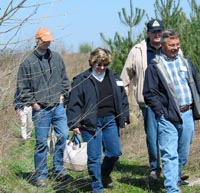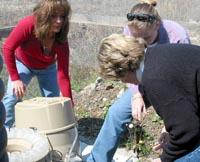Washington Congressional Staffers Take Tour of Reclaimed Mine Land
Washington Congressional Staffers Take Tour of Reclaimed Mine Land


Participants watch demonstrations of hydrology equipment.
Lawmakers in Washington D.C. sometimes are physically removed from the areas their policies affect, with little opportunity to see the results of their efforts. University of Kentucky College of Agriculture professionals wanted to change that and show them firsthand some of the research efforts to reclaim surface mine land to help enhance the vitality of eastern Kentucky’s environment and economy.
Members of several state agencies, UK Cooperative Extension professionals, and mining industry representatives recently hosted a group of congressional staff members for a tour of reclaimed mine land on active mines, UK’s Robinson Forest and the Center for Applied Energy Research. Tour organizers hope these staffers will be able to gain a better understanding of reforestation and reclamation efforts in eastern Kentucky so they can relay the information to their representatives and senators back in Washington D.C.
“Partnership is the way we have to succeed,” said Don Graves, chair of the UK forestry department. “What has been done in the past in research is that people have gone out and done a plot here and a plot there and then they try to relate that back to each other. We don’t do that – everyone works together and we get all the different information at the same time.”
Tour participants saw how elk have been reestablished in eastern Kentucky and thrive on surface mines like Starfire Mine in Knott County. They saw the difference between trees planted on compacted soil versus those cultivated in ripped or uncompacted soil. They also saw a thriving cattle enterprise on Pine Branch Mine in Perry County.
“When you see the compacted soil with short trees, only 3-to-4 feet tall, that have been here 10 years and then you see a set of trees that have been here for four years that are 15 feet tall, that’s quite a comparison,” said Bill Schweri, UK director of federal relations and sponsored program development. “The best way to change people’s attitudes and opinions about the way we’re going about reclaiming mine land is to get them out here to see this.”
Schweri went on to say that reclaiming mine land is critical to the coal industry in Kentucky.
“The coal industry operates on a pretty slim margin these days, and it has for years,” he said. “So, any efficiency we can develop that they can implement is great so they make more money and put more jobs out there for Kentuckians and boost the state’s economy.”
Tree planting on surface mines returns economic and ecological diversity to the areas it impacts. Everyone from environmentalists, coal and mining industry workers and foresters to Extension professionals, businessmen and lawmakers have an interest in how mine land is reclaimed.
“You can talk about it over the phone, e-mail pictures or watch videos, but until you get out there you don’t realize we’ve all got common interests,” said Michael Higdon, legislative assistant to U.S. Rep. Hal Rogers. “Mining folks have very similar interests, to a degree, as environmental groups. What they really want is to have places where families can live and enjoy and where folks from out of the area can come and visit. We can make all that happen with the resources that are unique to eastern Kentucky including coal, trees and forests.”
Graves said there is so much to be learned and one person working alone can’t do it all.
“It’s necessary that we have as many people on the team as we can get,” he said.”
